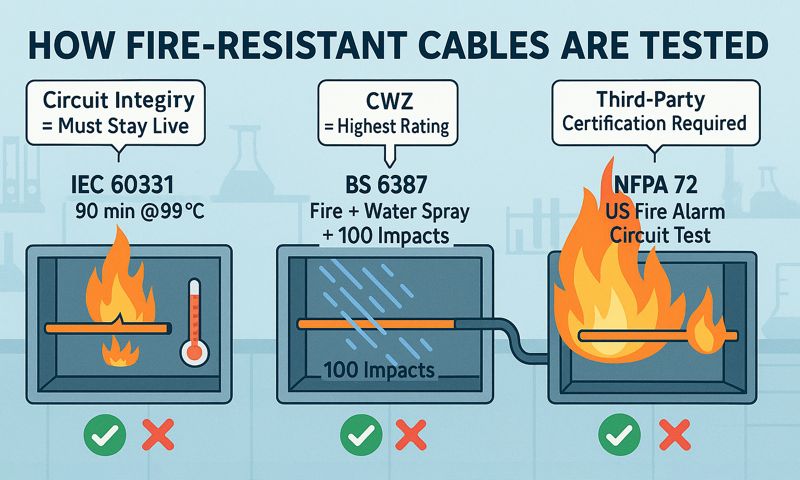Cable & Wire | High quality and excellent service at reasonable prices.
info@zion-communication.com
Author: Luke Publish Time: 27-08-2025 Origin: Site
When a building goes up in flames, time is of the essence. So are the cables inside it.
Standard cables can fail within minutes of exposure to flames. But fire resistant cables are built to keep critical systems running — even under extreme heat. They help fire alarms sound, emergency lights stay on, and smoke control systems work when people need them most.
At Hangzhou Zion Communication Co., Ltd, we design and supply fire alarm cables that meet international safety standards. Our range supports fire detection, monitoring, signaling, control circuits, and security systems. All our cables are tested for performance and reliability. If you don’t see the exact product you need, we offer custom cable design — from conductor size to jacket color and material.
Let’s look at what makes a cable truly fire resistant — and how to choose the right one for your project.
LSZH (Low Smoke Zero Halogen) cables are flame-retardant — not fire resistant.
That’s an important difference.
LSZH cables are made without halogen materials like chlorine or fluorine. When burned, they produce very little smoke and no toxic gases. This is crucial in enclosed spaces like subways, hospitals, and office buildings, where smoke inhalation causes most fire-related deaths.
But here’s the catch:
An LSZH cable may stop spreading flames, but it can still lose electrical function in a fire.
So, while LSZH is a smart choice for indoor safety, it should not be used alone for life-critical circuits unless it also has circuit integrity certification.
True fire resistant cables must pass strict tests that simulate real fire conditions.
The most common types include:
Made with copper conductors and magnesium oxide insulation
Can withstand fire for up to 3 hours
Fully inorganic — no melting, no smoke
Used in nuclear plants, tunnels, high-rises
Drawback: expensive and hard to install
Use mica tape to protect conductors
Covered with LSZH jacket
Maintain operation for 90–120 minutes at 950°C
Easier to terminate than MI cables
Compliant with IEC 60331 and BS 6387
These are tested under three conditions:
C – Fire exposure (950°C, 90 min)
W – Fire + water spray
Z – Fire + mechanical impact
A cable rated CWZ (per BS 6387) can survive flame, water, and physical shock — making it ideal for emergency systems.
Not every circuit needs fire resistance. But the ones that do are mission-critical.
You must use fire resistant cables for:
Fire Alarm Systems
Must signal danger as fire spreads
Emergency Lighting
Guides evacuation when power fails
Smoke Extraction Fans
Keeps escape routes clear
Fire Pumps & Sprinklers
Needs continuous power to activate
Voice Evacuation Systems
Provides real-time instructions
Security & Access Control
Prevents trapping people inside
In many countries, codes like NFPA 72 (US), BS 7671 (UK), and IEC 60331 (global) require fire resistant cables for these systems. Using standard cables instead can lead to code violations, insurance denial, or worse — loss of life.
No. Plenum cables are not fire resistant.
Plenum-rated cables (like CMP in the US) are designed for air-handling spaces — such as drop ceilings and HVAC ducts. They must pass the UL 910 Steiner Tunnel Test, which measures flame spread and smoke density.
They are:
Flame-retardant
Low-smoke
Safe for indoor air quality
But they are not tested for circuit integrity. Once exposed to fire, they may stop conducting electricity within minutes.
If you need both plenum rating and fire resistance, look for dual-certified cables — though they are rare and often custom-made.
Choosing the right supplier matters. Not all cables labeled “fire resistant” are truly tested or certified.
Top manufacturers provide:
Full compliance with IEC 60331, BS 6387, or EN 50200
Third-party test reports from accredited labs
Clear labeling of fire endurance time (e.g., 90 min)
Support for installation and inspection
ZION COMMUNICATION is a trusted name in fire alarm cabling. Our cables are:
Designed for 90-minute circuit integrity
Built with mica tape insulation and LSZH jackets
Available in multi-pair, shielded, and flexible versions
Compliant with CE, RoHS, GB, and IEC standards
We work with contractors, system integrators, and OEMs across Asia, Europe, and North America. Whether you need off-the-shelf or custom-designed fire resistant cables, we help you meet code and stay on budget.
Only if the circuit will shut down during a fire, e.g., a coffee machine. For emergency circuits, always use a cable with specified circuit integrity.
Request:
Get a test report from the manufacturer, e.g., IEC 60331-25 testing
See the certification on the cable jacket, e.g., BS 6387 CWZ wiresbend
Find out the cable’s endurance time, e.g., how long it can withstand fire at 950 °C

Yes — about 20–30% more than the standard LSZH version. Fortunately, the cost premium pales compared to the damage caused by no cable.
Yes, but exercise care. Follow the manufacturer’s bending radius, termination, and support guidelines. Damaged insulation strips away the fire-resistance rating.
Absolutely. ZION’s expert cable engineers can adjust:
Conductor size (16 to 24 gauge)
Pairs (1 to 25+ pairs)
Jacket color (red for fire cable)
Shield (foil + drain, braided)
Voltage rating (300 to 600 V)
Send your specifications — we’ll custom build a cable that’s perfect for your project.
Fire resistant cables are not just another part of the wiring system. They are a lifeline.
Don’t confuse flame-retardant, LSZH, or plenum cables with true fire resistance. Only circuit integrity-tested cables can be trusted to perform during a fire.
At ZION COMMUNICATION, we help engineers and contractors make smart, code-compliant choices. Our fire alarm cables are built to last — before, during, and after a fire.
Need a reliable, certified fire resistant cable?
Contact us today for samples, technical data, or a custom quote.
Contact us for more information

Luke Han is a Product Manager and Director at Zion Communication,
Specializing in fire, security, and alarm solutions. With extensive industry experience,
Dedicated to delivering high-performance, reliable products that are tailored to customer needs.
luke@zion-communication.com
0086 19883212162
